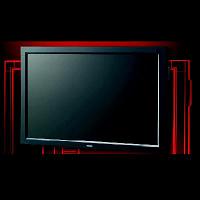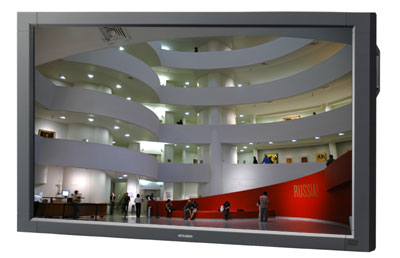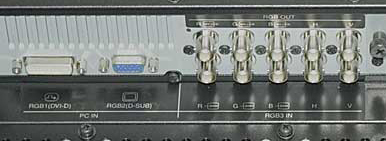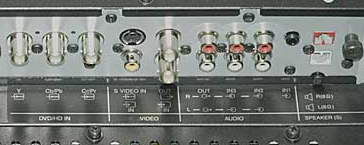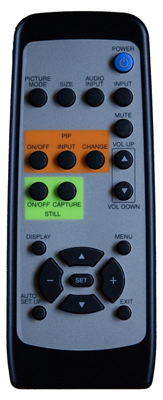
|
|
 |

|


Dick De Jong July 24, 2006 HDTV Solutions I rarely wear a coat and cravat, but I am donning the proverbial blue blazer and red power tie to review the Mitsubishi 40" MDT402S Commercial LCD Monitor Display - the key descriptor here being commercial. This product, (with a WXGA [1366 x 768] resolution in a 16:9 video format), is designed and built for heavy-duty business uses such as digital signage; so, it needs a more button-down analysis. For many of you who are building home theaters, monitors (meaning TVs without tuners) are a great solution when your primary video source derives from satellite or cable set top boxes. But let me reiterate, the MDT402S is a commercial monitor (with a corresponding price tag of $5995) and is not for the home videophile unless you are considering constructing a multiple screen video wall in your rumpus room. With that said, if you are in the market for a monitor for your boardroom or classroom, read on. (Of course, if you are just curious about what features make a monitor commercial-class, you are more than welcome to tag along.)
Out of the Box The crate was impressive, but its bulk was not especially conducive to mounting a flight of stairs. (The wheels could also use a locking mechanism to prevent it from wandering away unattended.) So, out of the box, I was relieved to discover one of the MDT402S monitor's commercial features. It has two solid handles screwed into the back top of the frame. At 64 pounds (with stand), the monitor was definitely one-person luggable - though the Mitsubishi manual cautions that moving or installing the monitor must be done with two or more people. So for those installations where husky Teamsters are not available, you may want to bring a pocketful of tip money. And to ease engineering concerns, the metal frame back contains two lines of mounting screw holes that should accommodate almost any wall mount configuration. The red/green power indicator, (which also acts as the remote control sensor), provides the only spot of color on the otherwise unassuming thin (about two inches) black bezel front. The Control Panel buttons are facing down and out of sight on the bottom right side of the monitor. This clean, minimalist look may not win any beauty contests; but for tasks like digital signage, you want the customers to be watching to the message, not admiring the messenger. Setup
Showing its industrial pedigree, the MDT402S has three RGB inputs: a DVI-D (HDCP), a mini D-Sub 15 pin, and a five Input BNC combo (R, G, B, H, and V). For looping video, there's also a mirror five Output BNC group.
Next in line is what Mitsubishi calls a DVD/HD connector. Labeled Y, CbPb, CrPr, again they are BNC types. Rounding out the video inputs are an S-Video, 2 composite connectors (BNC and RCA), and a BNC composite video out. For audio, the monitor provides three stereo inputs (2 RCA and 1 mini) and one stereo output (RCA). The MDT402S does not include speakers but it does have stereo speaker terminals (with an output impedance rating of 7W x 7W [8 Ohm]). For this reason, I did not test the monitor's audio capabilities. Finally, and most importantly - if you plan to network this unit with others - on the side are two mini D-Sub 9 pin connectors (1 In and 1 Out). With a daisy chain setup, one computer with the right 3rd party software could control numerous monitors. At InfoComm, some vendors were touting programs that could handle up to at least 1000 TVs at once. Mama Mia! Alas, since Mitsubishi did not offer to send enough monitors to muster a video array, I could not test any of their networking capabilities. Hooking up to the MDT402S was fairly straightforward. The DVI enabled OPPO DVD player was plugged into the DVI input. Once again, when making video adjustments, different inputs allow you access to varying ranges of controls. For example, with the monitor set to the DVI connection, I was presented with a full menu of video tweaks (which are also available for the other two RGB inputs): Brightness, Contrast, Sharpness, Black Level, Color Control, and Color Temperature. Of note, the Color Control menu offers seven sliders for R, Y, G, C, B, M and Saturation. To calibrate the monitor, I played the Digital Video Essentials DVD in the Oppo. I found that the Black Level control was particularly influential. At its factory setting of 50, I had to turn down Contrast and Brightness almost to 0 to obtain a satisfactory result. But by turning the Black Level to 46, I could bring back Brightness and Contrast to around 50, which allowed much more latitude for finer adjustments.
The remote control could not be described as svelte and it was more comfortable in my hand when it was turned upside down. However, it is easy to navigate around the remote because it isn't overpopulated with buttons. Most of the fine-tuning controls are located in the extensive On Screen Display (OSD) menus, which you can move off to the side of the screen to facilitate adjusting test patterns. After sliding around the Color Controls, the colors were on the mark and consistent across the screen. Next, I wanted to test the monitor in a real world situation. Here's a hint from my real world, don't try to judge the color of a monitor from watching the first half hour of the Master and Commander DVD, which seems to take place mostly at night, or inside the ship, or during a storm, or all three at once. Though the shadowy scenes do furnish a true test of a monitor's contrast and the MDT402S, which is rated at 1000:1 Contrast Ratio, performed quite adequately but not Admiralably. (For appraising the perky color world, you might try a polychromatic pic like Legally Blonde.) For my color gauge, I hooked up a Dish Network HD receiver to the monitor. The images on ESPNHD from the replay of the Germany vs. Portugal World Cup match were stunning. The colors were rich, saturated and true. The sharpness of the picture almost induced that 3D Nirvana that incites HD enthusiasts to wax poetic. Of course, if you switch to the non-HD broadcast, you swear that you have just crossed over the video equivalent of the River Styx. That is no strike against the MDT402S. Remember the chant, "HD programming for HDTVs." Lest we forget, the MDT402S is a commercial product, so the next step was to see how it handled computer images. Since Mitsubishi is considerate enough to include a mini D-Sub 15 pin to mini D-Sub 15 pin cable in the MDT402S package, making the connection with a Dell Inspiron E1505 laptop was fairly painless. The only hiccup I encountered was that the monitor did not read the resolution of the computer output. After a bit of fiddling with both the laptop and the monitor, the best match was to set the computer to 1280 x 768 and the MDT402S to 1500 x 768, which cut off only about two pixels from the top and bottom of the laptop output. The image quality from the computer source was clean, bright and sharp. The MDT402S handled Internet text handsomely. Photoshop images were true. One could get spoiled using this as a computer monitor. As an added touch, the enclosed CD included an ICC color profile for the monitor, which allows you to soft proof content in Photoshop that you are preparing to display on this unit. Professional Driver on a Closed Course The rigors of digital signage applications can sometimes cause image persistence, where a ghost image lingers. To mitigate the problem, a Screen Saver function slightly expands and moves the image in four directions at a time interval that you can set. You also can program a schedule for turning on and off the monitor as well as picking which input source to play. The manual, (which has its share of Asia-speak: "Display by the inputed
signal aspect ratio by PC signal"), describes a host of other features
that I won't cover here like PIP, POP, Black Level Expansion, Clock Phase
and Gamma Selection. Needless to say, the MDT402S offers enough tweaks to keep the most dedicated video grease monkey jumping for joy. Conclusion If you are in the market for a commercial grade monitor, you should definitely check out the MDT402S. |
Bookmark:
![]() del.icio.us
del.icio.us
![]() Reddit
Reddit
![]() Google
Google
| Send this Page | Print this Page | Report Errors |




